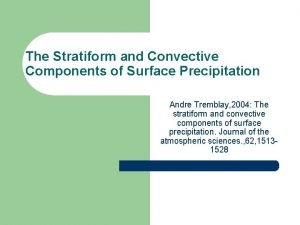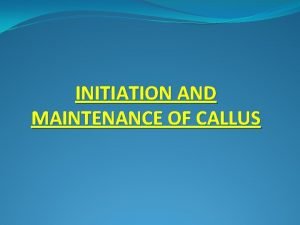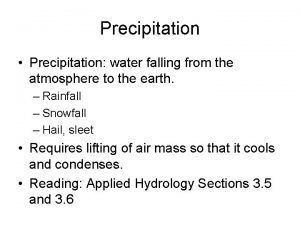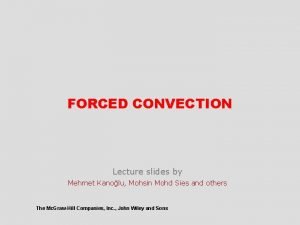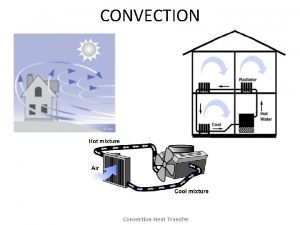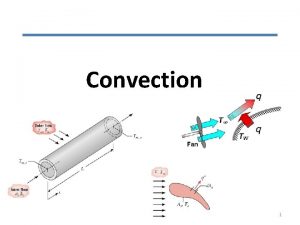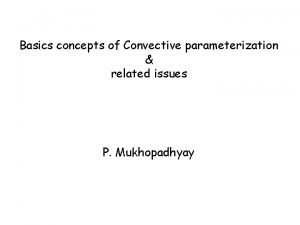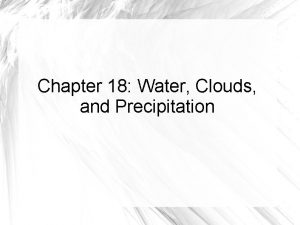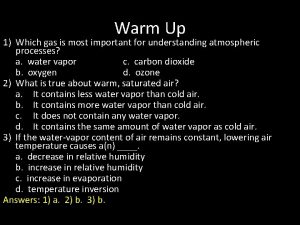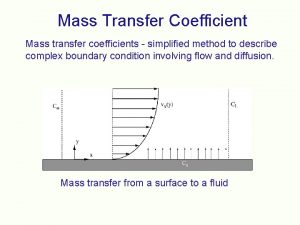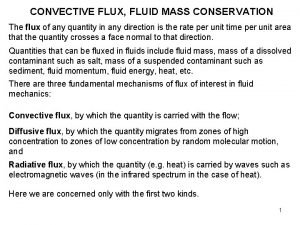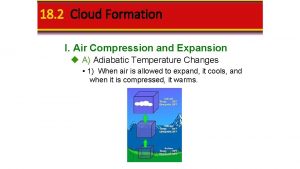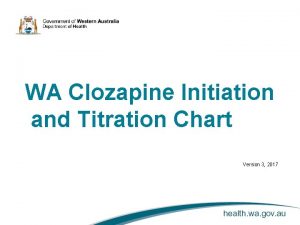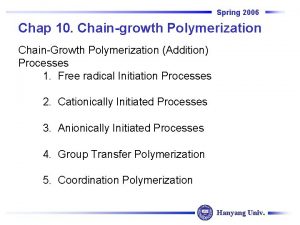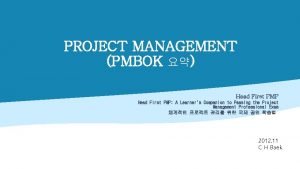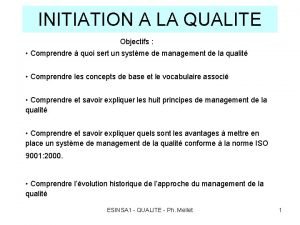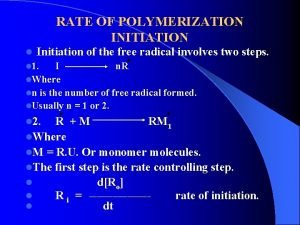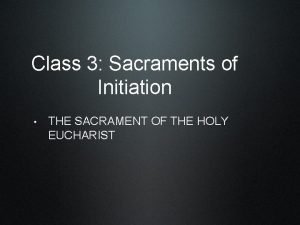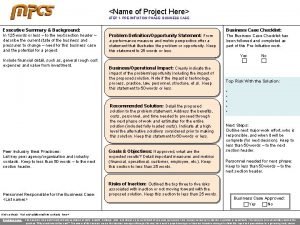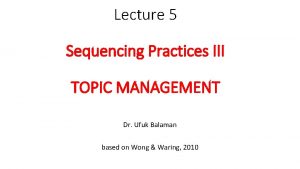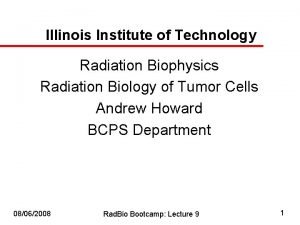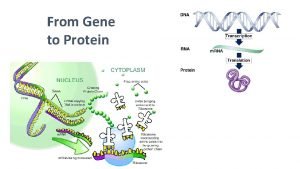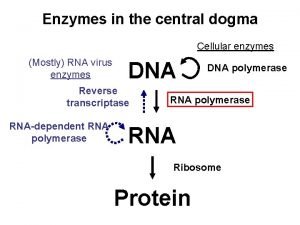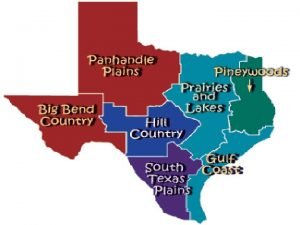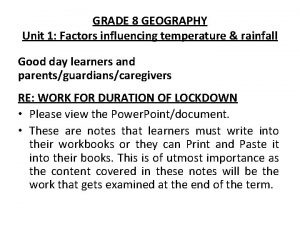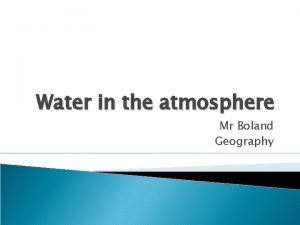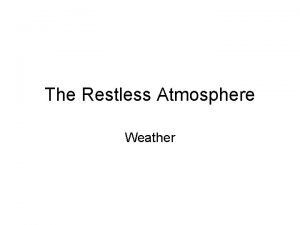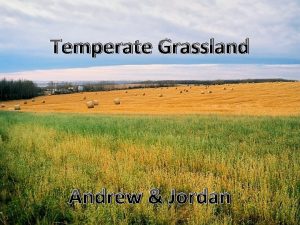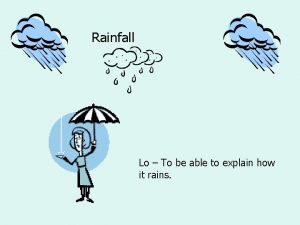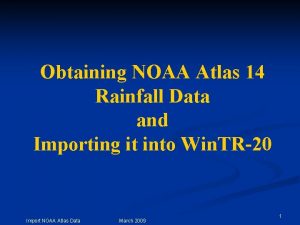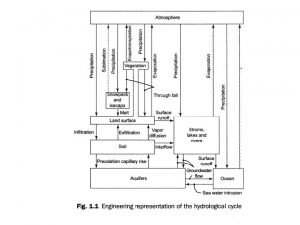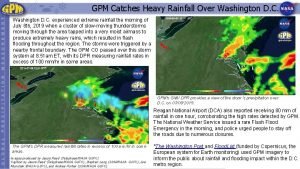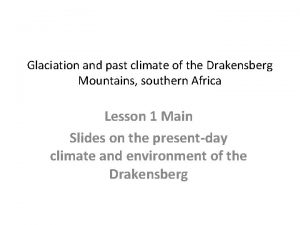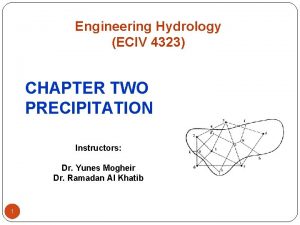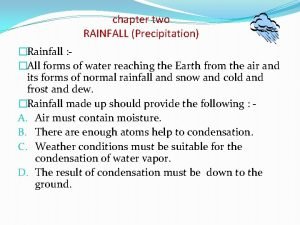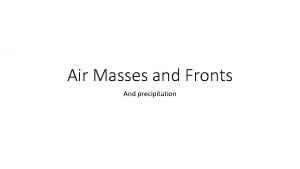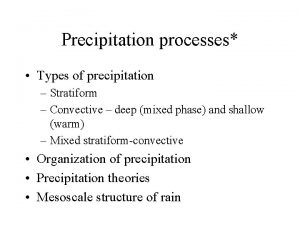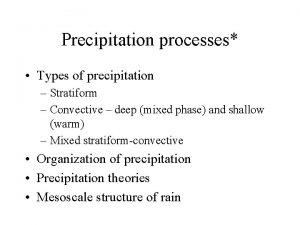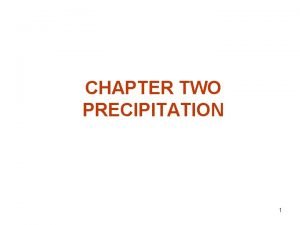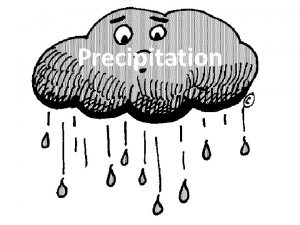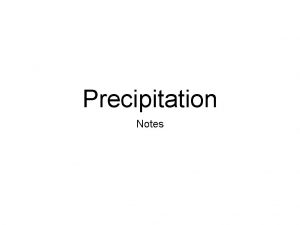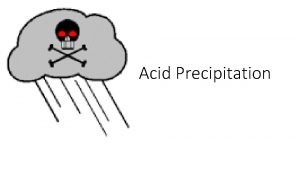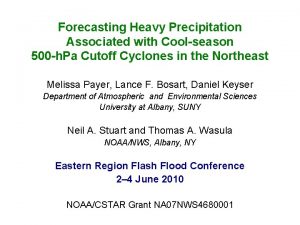Forecasting convective rainfall convective initiation heavy precipitation and





























































- Slides: 61

Forecasting convective rainfall: convective initiation, heavy precipitation and flash flooding Robert Fovell University of California, Los Angeles rfovell@ucla. edu

Heavy precipitation at a location = intensity + longevity

Common sources of heavy precipitation in U. S. • Mesoscale convective systems and vortices • Orographically induced, trapped or influenced storms • Landfalling tropical cyclones

Mesoscale Convective Systems (MCSs)

MCSs & precipitation facts • Common types: squall-lines and supercells • Large % of warm season rainfall in U. S. and flash floods (Maddox et al. 1979; Doswell et al. 1996) • Initiation & motion often not well forecasted by operational models (Davis et al. 2003; Bukovsky et al. 2006) – Boundary layer, surface and convective schemes “Achilles’ heels” of regional-scale models – Improved convective parameterizations help simulating accurate propagation (Anderson et al. 2007; Bukovsky et al. 2006) • Supercells often produce intense but not heavy rainfall – Form in highly sheared environments – Tend to move quickly, not stay in one place

Number of events Seasonality of flash floods in U. S. Contribution of warm season MCSs clearly seen Maddox et al. (1979)

Linear MCS archetypes (e. g. , squall-lines) 58% 19% Parker and Johnson (2000)

Squall-lines usually multicellular

The multicell storm Browning et al. (1976) Four cells at a single time Or a single cell at four times: unsteady

The multicell storm Unsteadiness = episodic entrainment owing to local buoyancy-induced circulations. Browning et al. (1976) Fovell and Tan (1998)

Storm motion matters How a storm moves over a specific location determines rainfall received Doswell et al. (1996)

Storm motion matters Doswell et al. (1996)

Forecasting MCS motion (or lack of motion…)

19980714 - North Plains

Some common “rules of thumb” ingredients • CAPE (Convective Available Potential Energy) • CIN (Convective Inhibition) • Precipitable water • Vertical shear - magnitude and direction • Low-level jet • Midlevel cyclonic circulations

Some common “rules of thumb” • MCSs tend to propagate towards the most unstable air • 1000 -500 mb layer mean RH ≥ 70% • MCSs tend to propagate parallel to 1000 -500 mb thickness contours • MCSs favored where thickness contours diverge • MCSs “back-build” towards higher CIN • Development favored downshear of midlevel cyclonic circulations

H r. R ye la % 70 70% RH rule of thumb Implication: Relative humidity more skillful than absolute humidity RH > 70% # = precip. category Junker et al. (1999)

MCSs tend to follow thickness contours Implication: vertical shear determines MCS orientation and motion. Thickness divergence likely implies rising motion

Back-building towards higher CIN Lifting takes longer where there is more resistance

Corfidi vector method Propagation is vector difference P=S-C Therefore, S = C + P

Example

Schematic example We wish to forecast system motion So we need to understand what controls cell motion and propagation

Individual cell motion • “Go with the flow” • Agrees with previous observations (e. g, Fankhauser 1964) and theory (classic studies of Kuo and Asai) Cells tend to move at 850 -300 mb layer wind speed* Corfidi et al. (1996) *Layer wind weighted towards lower troposphere, using winds determined around MCS genesis. Later some slight deviation to the right often appears

Individual cell motion Cells tend to move at 850 -300 mb layer wind speed Corfidi et al. (1996) Cell direction comparable To 850 -300 mb layer wind direction

Composite severe MCS hodograph Bluestein and Jain (1985)

Composite severe MCS hodograph Low-level jets (LLJs) are common Note P ~ -LLJ Bluestein and Jain (1985)

Propagation vector and LLJ • Many storm environments have a low-level jet (LLJ) or wind maximum Propagation vector direction P ~ -LLJ • Propagation vector often anti-parallel to LLJ Corfidi et al. (1996)

Forecasting system motion using antecedent information Cell motion ~ 850 -300 mb wind Propagation ~ equal/opposite to LLJ S = C - LLJ

Evaluation of Corfidi method Method skillful in predicting system speed and direction Corfidi et al. (1996)

Limitations to Corfidi method • Wind estimates need frequent updating • Influence of topography on storm initiation, motion ignored • Some storms deviate significantly from predicted direction (e. g. , bow echoes) • P ~ -LLJ does not directly capture reason systems organize (shear) or move (cold pools) • Beware of boundaries! • Corfidi (2003) modified vector method

http: //locust. mmm. ucar. edu/episodes

5 June 2004 X = Hays, Kansas, USA

Mesoscale Convective Vortices (MCVs)

Cyclonic vortex following squall line Not a clean MCV case

Potential vorticity (PV) anomalies PV anomaly shown drifting in westerly sheared flow Raymond and Jiang (1990)

Potential vorticity (PV) anomalies Ascent occurs on windward (here, east) side… destabilization Raymond and Jiang (1990)

Potential vorticity (PV) anomalies Cyclonic circulation itself results in ascent on east side Raymond and Jiang (1990)

Potential vorticity (PV) anomalies Combination: uplift & destabilization on windward side AND downshear side Raymond and Jiang (1990)

Composite analysis of MCV heavy rain events • Based on 6 cases poorly forecasted by models • Composite at time of heaviest rain (t = 0 h) • Heaviest rain in early morning • Heaviest rain south of MCV in 600 mb trough 600 mb vorticity (color), heights and winds. Map for scale only Schumacher and Johnson (2008)

Schumacher’s situation “Hairpin” hodograph: Sharp flow reversal above LLJ

Schumacher’s situation South side of MCV is windward at low-levels and downshear relative to midlevel vortex

Back-building Ground-relative system speed ~ 0 Schumacher and Johnson (2005) Doswell et al. (1996)

Evolution of the heavy rain event At t - 12 h (afternoon): - MCV located farther west - 900 mb winds fairly light 600 mb vorticity, 900 mb winds & isotachs Schumacher and Johnson (2008)

Evolution of the heavy rain event At t - 6 h (evening): - MCV drifted west - 900 mb winds strengthening (LLJ intensifying) 600 mb vorticity, 900 mb winds & isotachs Schumacher and Johnson (2008)

Evolution of the heavy rain event At time of heaviest rain (midnight): - 900 mb jet well developed - LLJ located east, south of MCV 600 mb vorticity, 900 mb winds & isotachs Schumacher and Johnson (2008)

Evolution of the heavy rain event At t + 6 h (morning): rain decreases as LLJ weakens 600 mb vorticity, 900 mb winds & isotachs Schumacher and Johnson (2008)

Episodes of MCSs & predictability Hovmoller diagrams reveal westwardpropagating MCSs Note “envelope” of several systems with “connections” Carbone et al. (2002)

MCV role in predictability Carbone et al. (2002)

“Training lines” of cells • In Asia, stationary front could be the Mei-Yu (China), Baiu (Japan) or Changma (Korea) front • Motion along the front and/or continuous backbuilding Schumacher and Johnson (2005)

X Record 619 mm in 15 h at Ganghwa, Korea shear Lee et al. (2008) Sun and Lee (2002)

2 -3 April 2006

Why did new cells appear ahead of the mature line?

New cell initiation ahead of squall-lines The waves themselves disturb the storm inflow Fovell et al. (2006)

New cell initiation ahead of squall-lines …some of which can develop into precipitating, even deep, convection Fovell et al. (2006)

14 km New cell initiation ahead of squall-lines 150 km Fovell et al. (2006)

Importance of antecedent soil moisture conditions (Generally not captured well by models)

Tropical Storm Erin (2007) http: //en. wikipedia. org/wiki/Image: Erin_2007_track. png

Erin’s redevelopment over Oklahoma Emanuel (2008) http: //www. meteo. mcgill. ca/cyclone/lib/exe/fetch. php? id=start&cache=cache&media=wed 2030. ppt

Erin inland reintensification • Hot and wet loamy soil can rapidly transfer energy to atmosphere • Previous rainfall events left Oklahoma’s soil very wet • Need to consider antecedent soil moisture and soil type Emanuel (2008) see also Emanuel et al. (2008)

Soil T as Erin passed Emanuel (2008)

end
 Stratiform rain
Stratiform rain Gravimetry steps
Gravimetry steps Co precipitation and post precipitation
Co precipitation and post precipitation What does ratey stand for
What does ratey stand for Basic i/o supervisor
Basic i/o supervisor Initiation and maintenance of callus culture
Initiation and maintenance of callus culture Project identification and initiation
Project identification and initiation Clouds fog or dew will always form when
Clouds fog or dew will always form when Convective rain
Convective rain Convective sigmet
Convective sigmet Convective clouds
Convective clouds Petukhov equation
Petukhov equation Characteristic length for cylinder
Characteristic length for cylinder Convective heat transfer coefficient formula
Convective heat transfer coefficient formula Convective parameterization
Convective parameterization What is frontal wedging
What is frontal wedging Localized convective lifting definition
Localized convective lifting definition Localized convective lifting
Localized convective lifting Mass transfer
Mass transfer Momentum fluid
Momentum fluid Localized convective lifting
Localized convective lifting Clozapine initiation chart
Clozapine initiation chart Dna transcription
Dna transcription Separation initiation return
Separation initiation return Initiation radical reaction
Initiation radical reaction Raci 차트
Raci 차트 Importance of project initiation
Importance of project initiation Initiation à la recherche en soins infirmiers
Initiation à la recherche en soins infirmiers Site initiation visit ppt
Site initiation visit ppt Inisiasi proyek adalah
Inisiasi proyek adalah Concept of home visit
Concept of home visit Jeanine
Jeanine Examples of the task archetype
Examples of the task archetype Site initiation visit
Site initiation visit Sensibilisation et initiation à la cybersécurité
Sensibilisation et initiation à la cybersécurité Knapp's relationship stages
Knapp's relationship stages A quoi sert la qualité
A quoi sert la qualité L'initiation
L'initiation Initiation à la démonstration 5ème
Initiation à la démonstration 5ème What are the 3 sacraments of initiation
What are the 3 sacraments of initiation Separation initiation return
Separation initiation return Revelation hero's journey
Revelation hero's journey Energy amplifier initiation
Energy amplifier initiation Pre initiation phase project management
Pre initiation phase project management Topic initiation
Topic initiation Initiation promotion progression
Initiation promotion progression Simultaneous transcription
Simultaneous transcription Initiation steps
Initiation steps Llano uplift plants
Llano uplift plants Llano uplift rainfall
Llano uplift rainfall 5 factors that influence temperature and rainfall grade 8
5 factors that influence temperature and rainfall grade 8 Convectional rain
Convectional rain Frontal rainfall
Frontal rainfall Temperate grassland definition
Temperate grassland definition Tropical deciduous forest rainfall
Tropical deciduous forest rainfall Relief rain
Relief rain Noaa atlas 14
Noaa atlas 14 Pune, india, has tried to increase its rainfall by
Pune, india, has tried to increase its rainfall by Isohyetal method example problems
Isohyetal method example problems Dc rainfall
Dc rainfall Wikimedia commons
Wikimedia commons Rainfall chapter 2
Rainfall chapter 2
